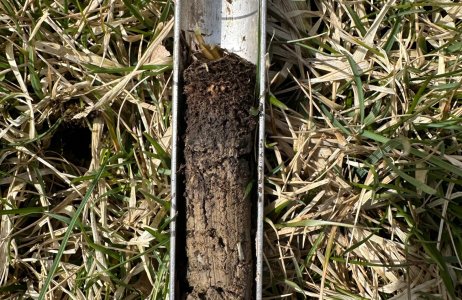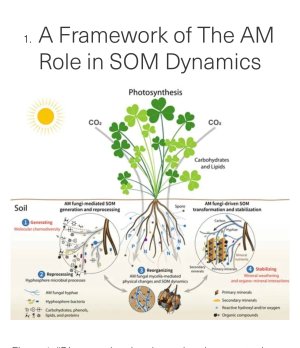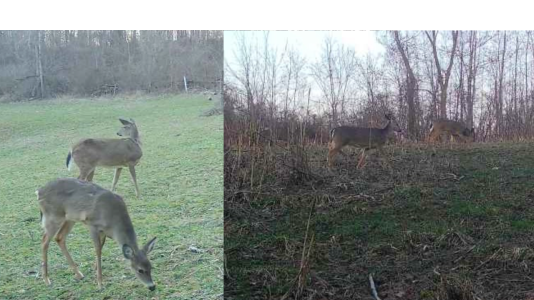-
If you are posting pictures, and they aren't posting in the correct orientation, please flush your browser cache and try again.
Edge
Safari/iOS
Chrome
You are using an out of date browser. It may not display this or other websites correctly.
You should upgrade or use an alternative browser.
You should upgrade or use an alternative browser.
Ohio Farm Tours
- Thread starter Buckhunter10
- Start date
Buckhunter10
5 year old buck +
Buckhunter10
5 year old buck +
Buckhunter10
5 year old buck +
Buckhunter10
5 year old buck +
Buckhunter10
5 year old buck +
Buckhunter10
5 year old buck +
Buckhunter10
5 year old buck +
Buckhunter10
5 year old buck +
Buckhunter10
5 year old buck +
This is a yard I’ve worked on for about 2 years.
It is primarily KY bluegrass
High PH and High CEC (7.8 and 18)
When we started I could hardly get a soil probe in 4inches.
2 years later - working to balance saturations, adding Vitalize Micros, foliar treating with Vitalize Fish Fert+Humics, and Seed Feed and Spectrum+Myco on the seed when over-seeding and we have topsoil!
That short of a period, in a monoculture and we are making things happen.
Now imagine how I fast we can make a change using high diversity like the 1-2 system.

It is primarily KY bluegrass
High PH and High CEC (7.8 and 18)
When we started I could hardly get a soil probe in 4inches.
2 years later - working to balance saturations, adding Vitalize Micros, foliar treating with Vitalize Fish Fert+Humics, and Seed Feed and Spectrum+Myco on the seed when over-seeding and we have topsoil!
That short of a period, in a monoculture and we are making things happen.
Now imagine how I fast we can make a change using high diversity like the 1-2 system.

Buckhunter10
5 year old buck +
The data that continues to back mycorrhizal seed inoculation, as well as the benefits of focusing on a system that promotes fungi propagation in our soils is staggering.
This is why from my gardens,food plots,lawns, orchards - I am always adding some Spectrum+Myco.
Here is just one article of many out there that highly some amazing research by some brilliant individuals.

 cid-inc.com
cid-inc.com

This is why from my gardens,food plots,lawns, orchards - I am always adding some Spectrum+Myco.
Here is just one article of many out there that highly some amazing research by some brilliant individuals.

Five Important Arbuscular Mycorrhizal Fungi Studies from 2024
Discover five studies from 2024 highlighting the benefits of arbuscular mycorrhizal fungi in enhancing soil health and agriculture
 cid-inc.com
cid-inc.com

Buckhunter10
5 year old buck +
How does somebody know if they should buy inoculant for their seed?
Sent from my iPhone using Tapatalk
I don’t plant without it. I think the cost benefit analysis is pretty straight forward. I use it for every tomato plant, seed, tree, etc. Even when I’ve done plfa testing and had fungi levels high, I still believe the benefit of having it, right on the seed and roots - getting that immediate or close to immediate symbiosis is highly beneficial and the data that continues to come out seems to jive as well.
So in my opinion- if someone has the funds to do so - do it. If not on every acre - do it on the most degraded area for a few seasons.
It is truly critical in soil aggregation not to mention nutrient update and stress mitigation.
All that to say - I look at it like an insurance policy
Bowsnbucks
5 year old buck +
Welter's catalog recommends certain crop seed varieties be inoculated. They told me by phone, that the seed varieties that need inoculant, get shipped with the appropriate inoculant already added. I had asked them if their seeds come pre-inoculated. FWIW.How does somebody know if they should buy inoculant for their seed?
Sent from my iPhone using Tapatalk
I don't know if all seed vendors pre-inoculate seed when needed.
Buckhunter10
5 year old buck +
That’s probably a rhizobium inoculant. We actually created our own that is a broad spectrum that covers every legume in our Summer Mix (I was tired of not having the correct bacteria for allWelter's catalog recommends certain crop seed varieties be inoculated. They told me by phone, that the seed varieties that need inoculant, get shipped with the appropriate inoculant already added. I had asked them if their seeds come pre-inoculated. FWIW.
I don't know if all seed vendors pre-inoculate seed when needed.
Legumes) and we added a humics base which helps with seed germ, water retention, etc.
Many clovers do come pre inoculated.
However - the above that @SD51555 and I were discussing is in regards to fungi inoculants - that’s a bit different but the evidence to use it is mounting. Especially in the market garden and row crop space.
Buckhunter10
5 year old buck +
Every time I fill the drill -
Seed
Seed Armr+
Seed Feed
Spectrum+Myco
I look at this as a great insurance policy. If I can get my seeds off to a good start - they are going to be better from drought to browse tolerance.
Seed
Seed Armr+
Seed Feed
Spectrum+Myco
I look at this as a great insurance policy. If I can get my seeds off to a good start - they are going to be better from drought to browse tolerance.
Buckhunter10
5 year old buck +

SPRING. FOOD. PLOTS. w/ Al Tomechko
Podcast Episode · Wing & Tail Boys · 03/27/2025 · 1h 5m
Buckhunter10
5 year old buck +
lol no. That’s a podcast I was on!Is this a phishing link? I just had that training at work.
Sent from my iPhone using Tapatalk
On my end it looks normal - does it look off?

